Solenopsis geminata (Fabricius)
  Type location Central
America (Atta geminata Fabricius, 1804: 423, queen; Roger,
1862c: 289, worker & male) - see below Type location Central
America (Atta geminata Fabricius, 1804: 423, queen; Roger,
1862c: 289, worker & male) - see below
junior synonym innota
(Solenopsis geminata F. var. innota n. var., Santschi, 1915c:
257, illustrated, all forms) from Gabon, Samkita, Faure; (see
Bolton, 1995).
Well known as one of the viciously stinging "fire-ants"  . .
|
There are numerous junior synonyms from the Americas - clypeatus,
mandibularis, paleata, cephalotes, glaber,
laboriosus, polita, drewseni, coloradensis,
linecumii, saxicola, innota, nigra,
mellea, laevissima, rufa (and its
junior synonym diabolus), eduardi (and its junior
synonym perversa), medusa (and its junior synonym bahiaensis)
and galapageia - for full listing see Trager (1991, link
below). One subspecies, micans, also was listed by Bolton
(1995: 387).
|
 The photomontage
of
the type queen is collated from http://www.antweb.org/specimen.do?name=casent0102533 The photomontage
of
the type queen is collated from http://www.antweb.org/specimen.do?name=casent0102533
Fabricius'
(1804) description of the queen is at  . .
|
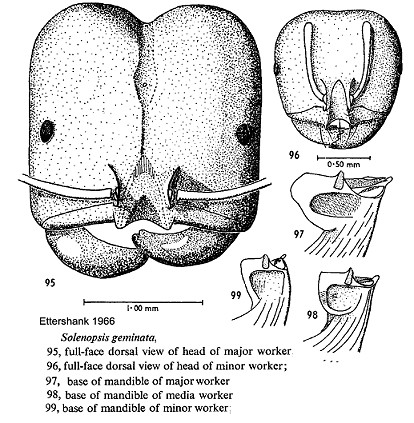 Roger's
(1862c) description is at Roger's
(1862c) description is at  . .
|
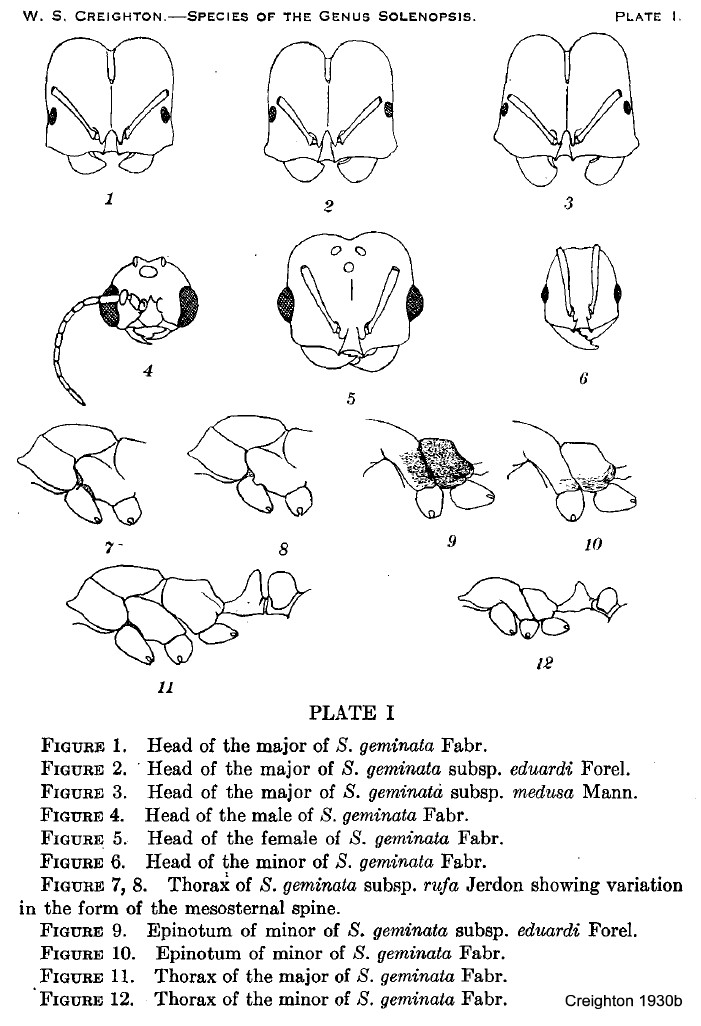 A
comprehensive illustrated description was provided by Creighton (1930:
163), this is at A
comprehensive illustrated description was provided by Creighton (1930:
163), this is at  . .
|
 A
comprehensive illustrated description was provided by Trager (1991:
163), this is at A
comprehensive illustrated description was provided by Trager (1991:
163), this is at  , ,  and and  . .
I note, however, that Trager's synonymic list drew
together the prior works of Creighton (1930) and Ettershank (1966:
136). There are some errors in Trager's list. For instance, the
Galapagos Islands form S. geminata var. galapageia
Wheeler (1922: 272) was listed as a variety of geminata by
Ettershank (1966) and not a synonym as cited by Trager. The synonymy of
S. geminata var innota Santschi (1915c:
257), from Gabon, Liberia and Congo, was attributed to Ettershank by
Trager but, in fact, Ettershank did not list innota at all.
Ironically, the two latter forms appear to be the only non-American
material examined by Trager. Trager noted the African population as
resembling the black form found in Georgia, Florida and the Antilles
but innota was given as reddish-yellow or brownish, with some
browner areas by Santschi (see my fuller treatment below).
|
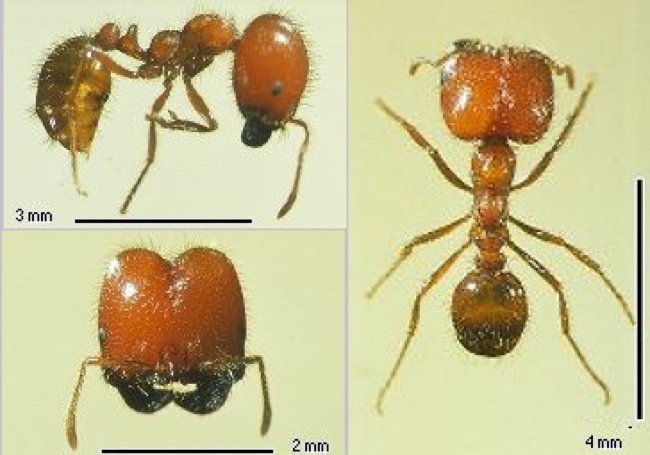 The
example right was edited from the Japanese
Ant Color Image Database, from where the following description
appears - Workers polymorphic, total body length ranging 3 to 5 mm.
Body reddish brown, head brown. In major workers: head almost square,
posterodorsal margin distinctly convex in frontal view; mandibles
robust, each with a strongly convex outer margin and 4 blunt teeth on
the masticatory margin; mandibular teeth obscure in some individuals;
clypeus with a pair of longitudinal carinae; eyes rather small, each
with more than 20 facets; anterior ocelli often present; antennal
scapes reaching nearly to posterior border of head; antennal club
longer than the 3rd to 9th antennal segments combined; legs, mesosoma
and gaster with numerous erect hairs. In minor workers: head almost
square in frontal view; mandibles 4-toothed; antennal scapes reaching
posterior margin of head; clypeus with a pair of longitudinal carinae;
posterolateral corners of propodeum carinate, the carinae reaching the
dorsal surface of the propodeum; subpetiolar process absent. The
example right was edited from the Japanese
Ant Color Image Database, from where the following description
appears - Workers polymorphic, total body length ranging 3 to 5 mm.
Body reddish brown, head brown. In major workers: head almost square,
posterodorsal margin distinctly convex in frontal view; mandibles
robust, each with a strongly convex outer margin and 4 blunt teeth on
the masticatory margin; mandibular teeth obscure in some individuals;
clypeus with a pair of longitudinal carinae; eyes rather small, each
with more than 20 facets; anterior ocelli often present; antennal
scapes reaching nearly to posterior border of head; antennal club
longer than the 3rd to 9th antennal segments combined; legs, mesosoma
and gaster with numerous erect hairs. In minor workers: head almost
square in frontal view; mandibles 4-toothed; antennal scapes reaching
posterior margin of head; clypeus with a pair of longitudinal carinae;
posterolateral corners of propodeum carinate, the carinae reaching the
dorsal surface of the propodeum; subpetiolar process absent.
|
African forms
Emery (1915c) noted that Solenopsis geminata F
and pylades Forel (then regarded as a race of geminata
but now a junior synonym of S. xyloni McCook, type location
USA) had recently been imported to Africa from America. He gave no
details of any sort. Santschi (1910c: 359) recorded it from
Brazzaville, Congo, received from Prof. Galli Valerio, without any
details. Wheeler (1922) listed findings from Liberia (Monrovia
by Delafosse), and in the Congo areas - Congo, Samkita
(F. Faure), Brazzaville (Valerio), Zaïre, Goma (Valerio). None
were among the Congo Expedition findings (Wheeler, 1922: 163). Trager
(1991) states: "The African population is less well known, but is found
in tropical West Africa. It resembles the black form found in Georgia,
Florida and the Antilles". Possibly he referred to the specimens
recorded by Santschi (1939f: 162) as Solenopsis geminata
Fabricius v. nigra Forel, from Guinea, Iles de Los, Ile Kassa
and Il Corail, one worker each. Forel's (1908b: 45) description of Solenopsis
geminata F. v. nigra n. var., from the Atlantic coast of
Costa Rica, is at  . This form is black with
coarser sculpturation. . This form is black with
coarser sculpturation.
|
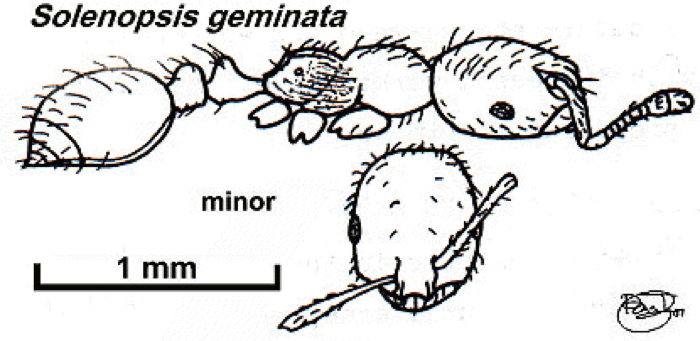 In Nigeria it is an introduced neotropical
species apparently
common in the Warri Delta, where it was known as "okubrass" (Bolton,
1973a). Specimens collected by A. Youdeowei were used for my drawing. In Nigeria it is an introduced neotropical
species apparently
common in the Warri Delta, where it was known as "okubrass" (Bolton,
1973a). Specimens collected by A. Youdeowei were used for my drawing.
Nigeria specimen (Taylor, 1980a: 43). MINOR - TL
2.43 mm, HL 0.65, HW 0.51, SL 0.50, PW 0.36
Colour yellow-brown, gaster slightly darker; shiny and polished.
Unsculptured except for faint rugoreticulation on the lateral mesonotum
and propodeum. Eyes moderately large. Very small obtuse denticles at
the lateral junction of dorsal and posterior faces of the propodeum.
|
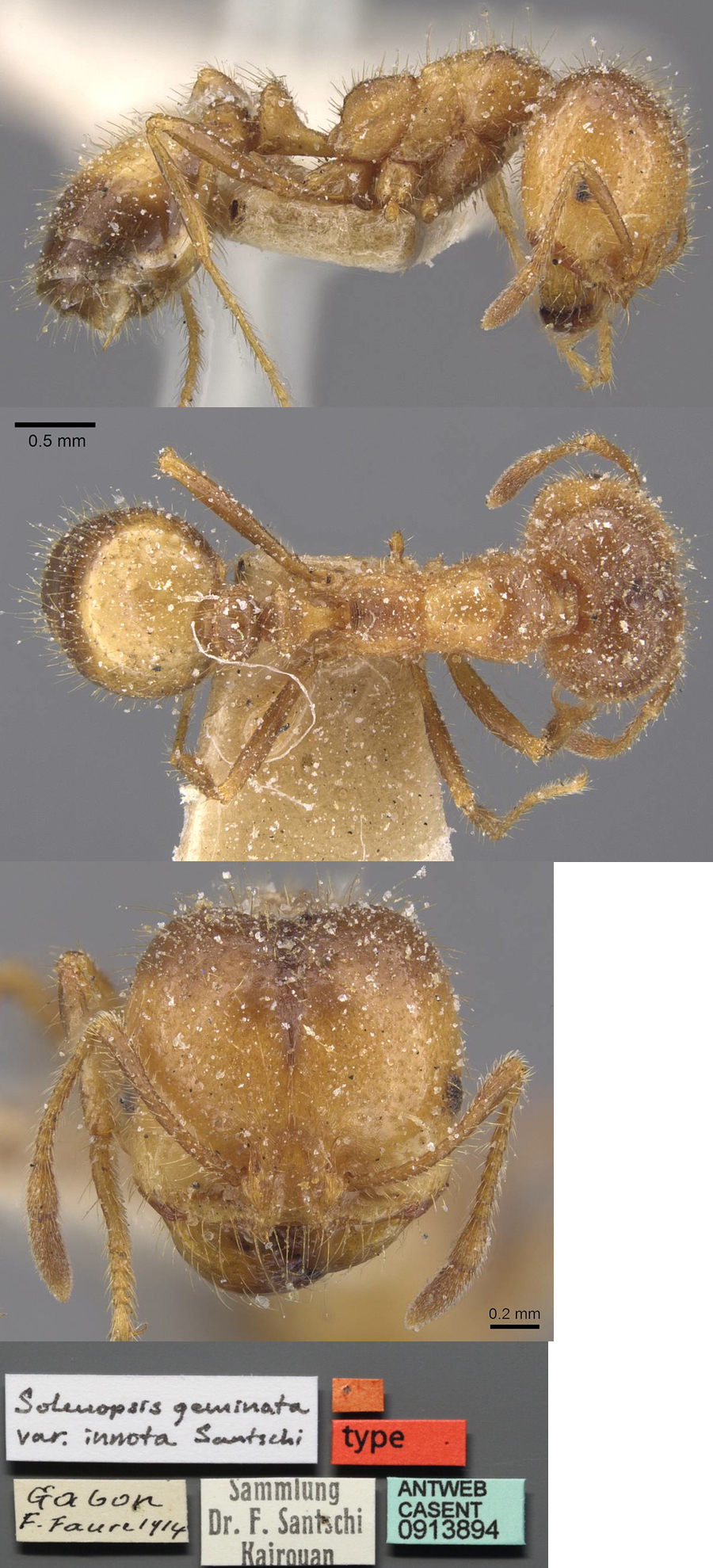 The
photomontage of
the innota type major worker is collated from http://www.antweb.org/specimen.do?name=casent0913894. The
photomontage of
the innota type major worker is collated from http://www.antweb.org/specimen.do?name=casent0913894.
|
Oxford University Museum
specimens
Solenopsis geminata
B Taylor det. |
Liberia
E Poirier
Yekepa Camp 4
SLAM 2
|
6.iv.2013
Nimba County
07°33’04" N
08°33’17" E
|
SLAM trap
Floodplain & marsh
501 m asl
media
|
2
|
 |
Solenopsis geminata
B Taylor det.
|
Cameroun
G Debout & A Dalecky
Cameroon 94
|
15.iv.2001
Kribi
2°56' N
9°55' E
|
both on soil and
surface at sardine oil bait
|
1
|
|
Solenopsis geminata
B Taylor det. |
Cameroun
G Debout & A Dalecky
Cameroon 95
|
15.iv.2001
Kribi
2°56' N
9°55' E
|
in herbaceous
vegetation in the garden of the Catholic Mission
|
3
|
 |
Solenopsis geminata
B Taylor det. |
Cameroun
G Debout & A Dalecky
Cameroon 04
|
24.iii.2001
Ebodjé
2°33.97' N
9°50.62' E
|
on soil and surface
in the village
|
3
|
 |
Solenopsis geminata innota
B Taylor det. |
Cameroun
G Debout & A Dalecky
Cameroon 49
|
15.ivi.2001
Ebodjé
2°33.97' N
9°50.62' E
|
on soil and surface
in the village
|
3
|
 |
|
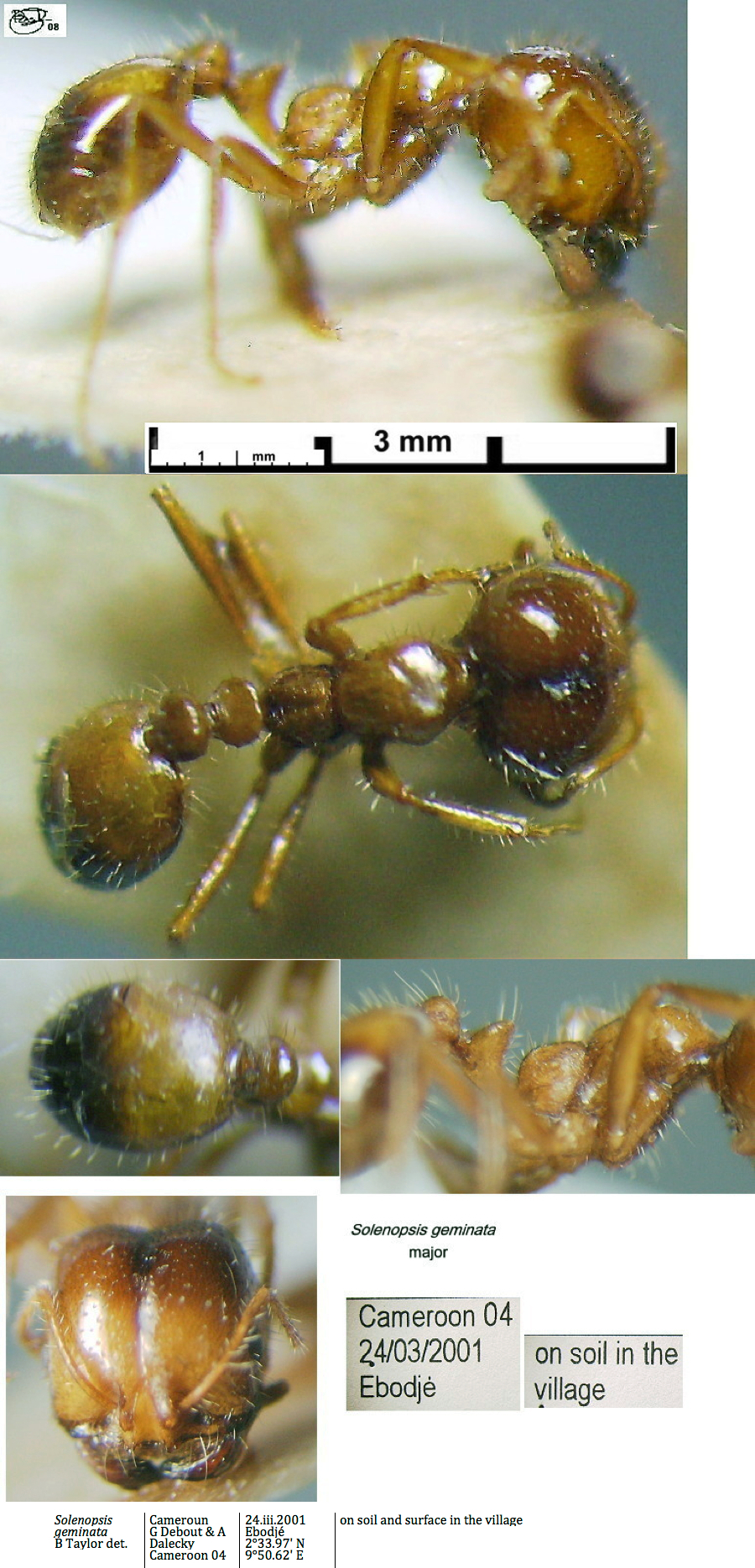 The photomontages
are of specimens collected in Cameroun
- south-western tropical coastal forest area between Edéa and Campo
(McKey Wolbachia project) - Cameroon 04, 24 March 2001, from
Ebodjé (or Ebodie, 2°33.97' N 9°50.62' E, 70 m from village; flat
terrain), on soil and surface in the village; Cameroon 94 and Cameroon
98, from Kribi (2°56' N 9°55' E, altitude 13 m, coastal), 15 April
2001, both on soil and surface at sardine oil bait; and Cameroon 95
from Kribi, 15 April 2001, in herbaceous vegetation in the garden of
the Catholic Mission. The photomontages
are of specimens collected in Cameroun
- south-western tropical coastal forest area between Edéa and Campo
(McKey Wolbachia project) - Cameroon 04, 24 March 2001, from
Ebodjé (or Ebodie, 2°33.97' N 9°50.62' E, 70 m from village; flat
terrain), on soil and surface in the village; Cameroon 94 and Cameroon
98, from Kribi (2°56' N 9°55' E, altitude 13 m, coastal), 15 April
2001, both on soil and surface at sardine oil bait; and Cameroon 95
from Kribi, 15 April 2001, in herbaceous vegetation in the garden of
the Catholic Mission.
These all seem to generally match the type form if one
allows for the variations noted by Trager, 1991). The largest specimen,
however, is much smaller than the majors illustrated by Ettershank and
Trager (shown above), with HW only 66% of the North American form;
Creighton gives the type form major as TL 6 mm. Unlike the type form,
in full face view the Cameroon 04 major does not broaden at the
anterior margin but narrows slightly with smoothly rounded anterior
corners.
The Cameroon 04 specimen is almost exactly the same size
and form as the type specimen of S. geminata galapageia Wheeler.
Creighton (1930: 65) noted on galapageia - "Aside from its
smaller size there is little to distinguish the worker .. from that of
the typical geminata", of the queen he noted the - "summit of
the petiole, when seen from behind, shows a very distinct obtuse median
notch" In almost all other queens of geminata that he examined
the summit of the petiole node is entire and slightly convex. The
Cameroon 04 major clearly has a notched petiole apex. Both majors in
Cameroon 04 and galapageia have quite sharp clypeal teeth.
Although not fully visible in the Antweb photographs (below), it seems
that the majors have a smoothly rounded profile to the propodeum and
the declivity is vertical with obvious concavity. The minima morphs of
Cameroon 04 and galapageia also are near identical (seem below).
The question that has to be posed, reiterating Trager
(1991) is whether the "western South American population of Colombia
and Peru ... apparently the source of source of the rather small S.
geminata typical of the Galapagos Islands" AND, from these Cameroon
specimens, one of the African forms, might be a distinct species.
Trager (1991) states: "The African population is less
well known, but is found in tropical West Africa. It resembles the
black form found in Georgia, Florida and the Antilles". There is no
evidence from the literature and certainly not from the Cameroon
specimens of the African specimens being of a "black form".
A fuller photomontage of the Cameroon 04 major and
photomontages of the minor morphs can be seen on the linked page Cameroon 04
- African type morphs.
|
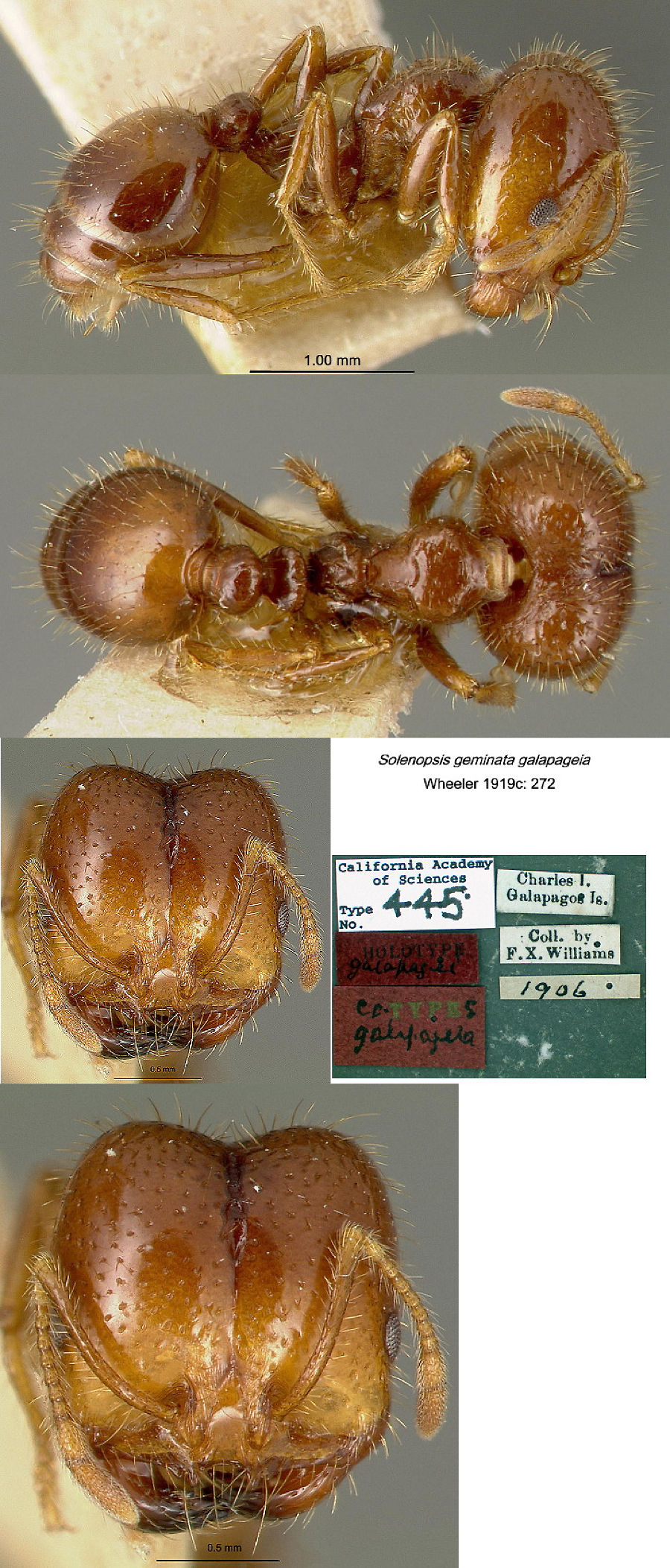 High quality
images of specimens from the Galapagos
Islands - S. geminata galapageia Wheeler 1919: 272 - and
other specimens can be seen on the Antweb site at http://www.antweb.org/getComparison.do?rank=species&genus=solenopsis&name=geminata&project=&project= High quality
images of specimens from the Galapagos
Islands - S. geminata galapageia Wheeler 1919: 272 - and
other specimens can be seen on the Antweb site at http://www.antweb.org/getComparison.do?rank=species&genus=solenopsis&name=geminata&project=&project=
|
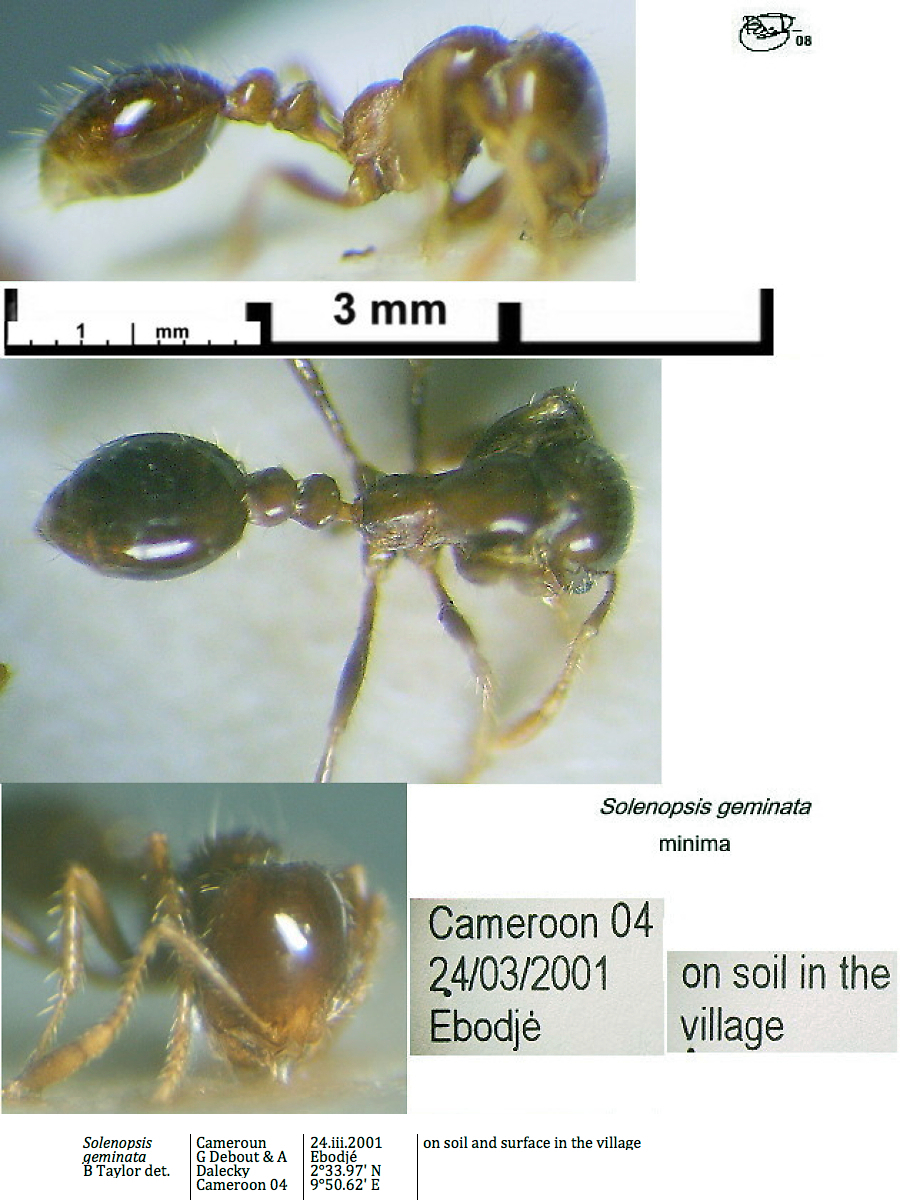 S.
geminata Cameroon 04 - African type minima S.
geminata Cameroon 04 - African type minima
|
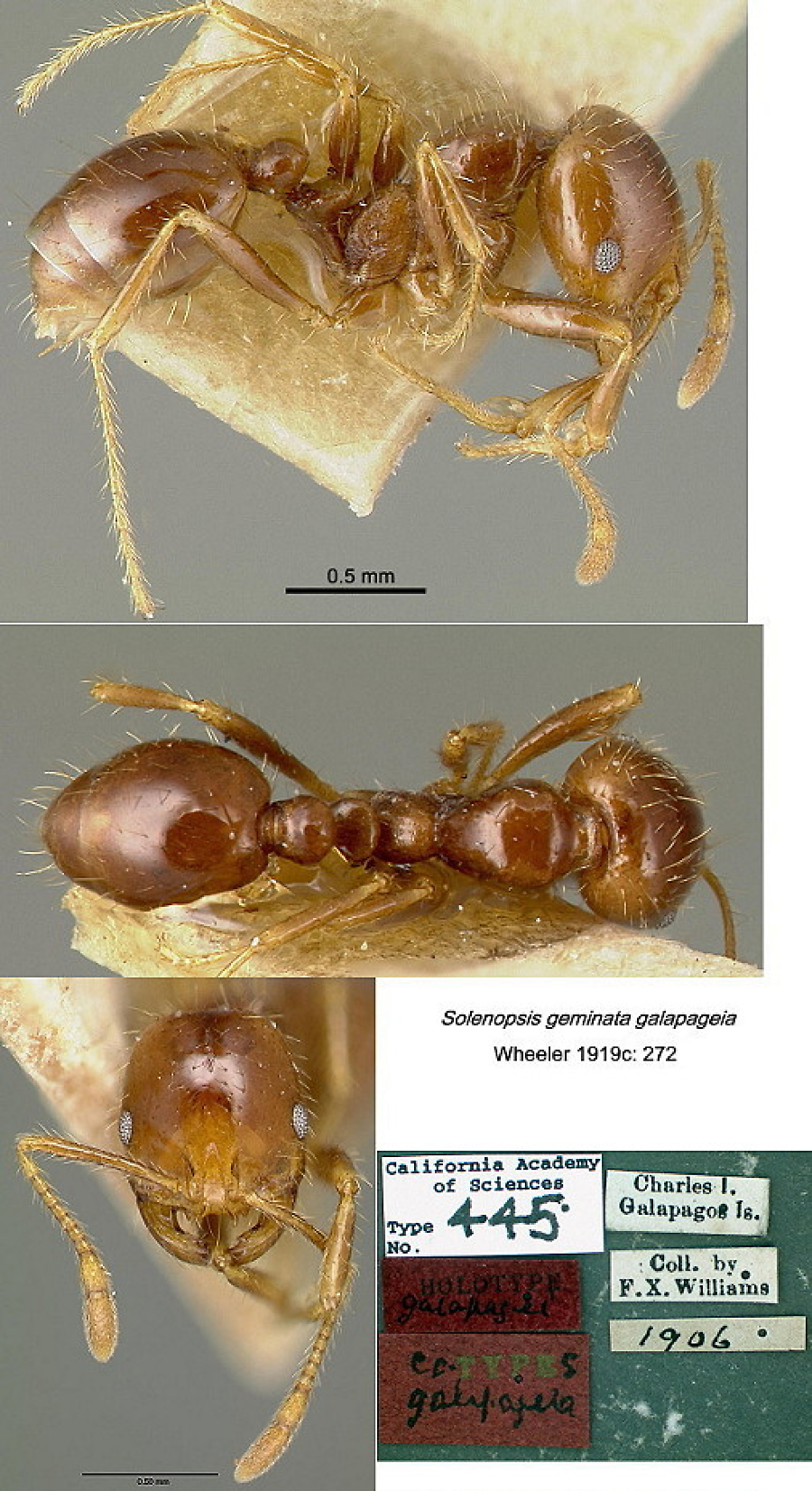 S.
geminata galapageia minima S.
geminata galapageia minima
|
Solenopsis geminata
innota Santschi
 Solenopsis
geminata F. var. innota n. var., Santschi, 1915c: 257,
illustrated all forms) from Gabon, Liberia and Congo.
The synonymy of S. geminata var innota Santschi (1915c:
257), from Gabon, Liberia and Congo. The synonymy with the type S.
geminata was given by Bolton, 1995: 388, as Wheeler, 1922; 877; but
Wheeler simply listed innota as a variety and, as common with
his 1922 catalogue, there is no evidence Wheeler examined the
specimens. Trager had attributed the synonymy to Ettershank (1966:
136). In fact Ettershank did not list innota at all. Santschi's
original text is on Solenopsis
geminata F. var. innota n. var., Santschi, 1915c: 257,
illustrated all forms) from Gabon, Liberia and Congo.
The synonymy of S. geminata var innota Santschi (1915c:
257), from Gabon, Liberia and Congo. The synonymy with the type S.
geminata was given by Bolton, 1995: 388, as Wheeler, 1922; 877; but
Wheeler simply listed innota as a variety and, as common with
his 1922 catalogue, there is no evidence Wheeler examined the
specimens. Trager had attributed the synonymy to Ettershank (1966:
136). In fact Ettershank did not list innota at all. Santschi's
original text is on  . .
My translation is
SOLDIER - TL 2-4.3 mm; head as long as wide (1.1 X 1.2 mm), more in
largest specimens, but smaller than the type. Clypeus quadridentate,
outer teeth very small, inserted in the base of the inner teeth.
Petiole node slightly more slender than the type, not as slim as
subspecies pylades. Colour yellow red or brownish; femora,
antennae and base of gaster rust yellow; rest of gaster, mid or
posterior quarter of head and mandibles more or less brown. Pilosity
and sculpture as type, sides of thorax more finely punctate.
MINOR - as the type, outer teeth of clypeus hardly visible; mandibles
striated, with 4 teeth and yellowish.
QUEEN - TL 7.5 mm; posterior quarter of head, alitrunk (except the base
of the sides), femora and gaster (other than a triangular basal area
and the borders) dark brown; rest rust or yellow rust. Wings hyaline,
otherwise as soldier.
MALE - TL 6.3 mm; brown black; lateral sutures and dorsal alitrunk,
mandibles, femora and antennae, variably dark yellow.
Specimens from Gabon, Samkita, by F. Faure, 1914. Others seen
from Liberia, Monrovia, by Delafosse; and Congo, Ngoma,
by Galle-Valerio. Probably a variety imported from America, where it is
widespread. It appears to develop rapidly in Africa and Faure wrote how
they are a great nuisance in (Gabon) plantations.
|
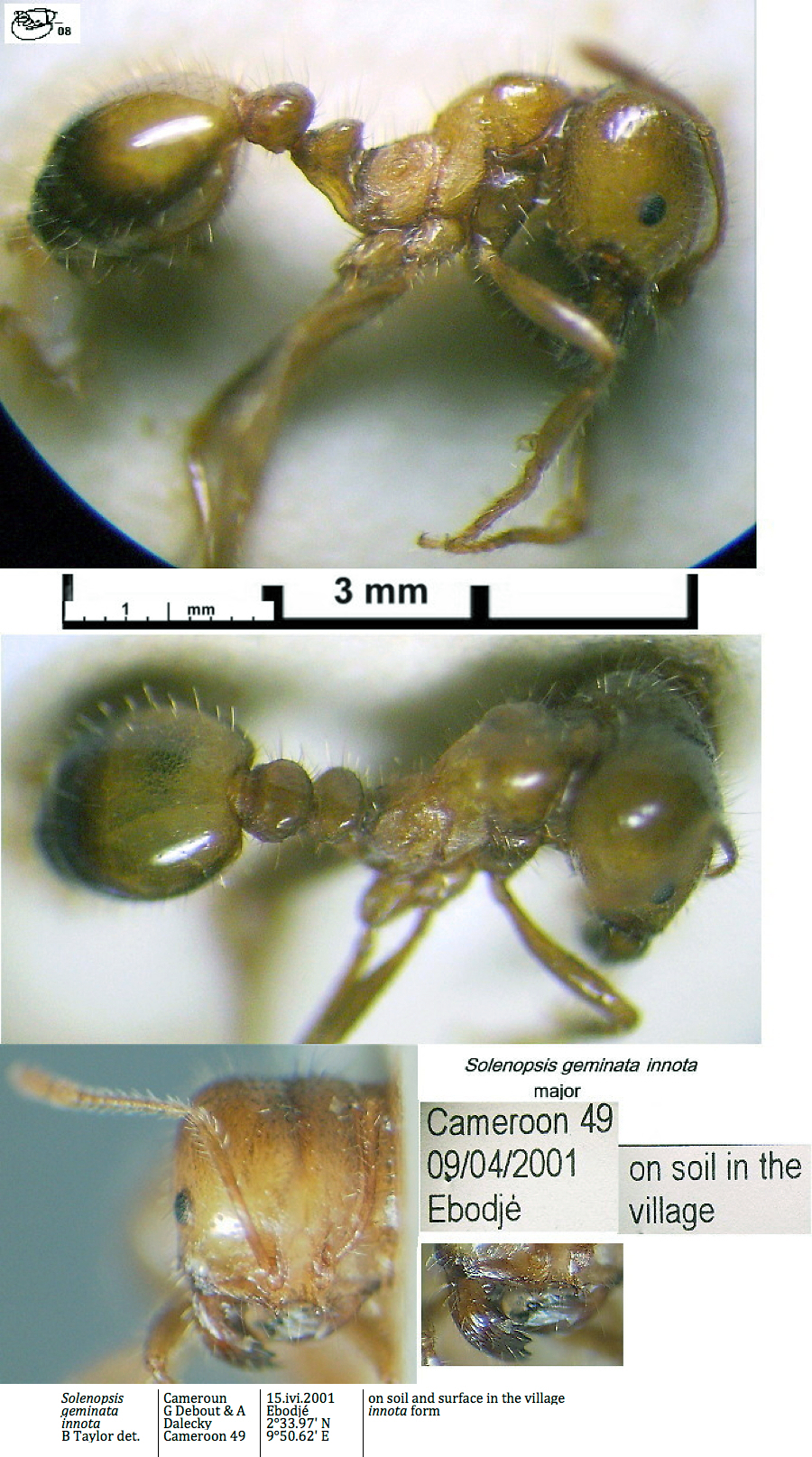 The
photomontage right and the queen below are specimens
from Cameroun - south-western tropical coastal forest area
between Edéa and Campo (McKey Wolbachia project) - Cameroon 49,
9 April 2001, from Ebodjé (or Ebodie, 2°33.97' N 9°50.62' E; flat
terrain), on soil and surface in the village. The
photomontage right and the queen below are specimens
from Cameroun - south-western tropical coastal forest area
between Edéa and Campo (McKey Wolbachia project) - Cameroon 49,
9 April 2001, from Ebodjé (or Ebodie, 2°33.97' N 9°50.62' E; flat
terrain), on soil and surface in the village.
A fuller photomontage of the Cameroon 49 major and
photomontages of the minor morphs can be seen on the linked page Solenopsis
geminata innota morphs.
Although Trager (1991) noted that he had seen the
Santschi specimens, he made no comment apart from listing the form as a
synonym of the type species. The specimens shown here, especially the
major, which in any case has the greatest use for diagnosis, appear to
be quite distinct from the several other samples collected in Cameroun.
Major - the major has a much more rounded profile
to the head; in full face view the specimen is squarer and has a near
straight occipital margin. The anterior clypeal margin (as noted by
Santschi) has a somewhat reduced but sharp main pair of teeth and much
smaller lateral teeth. The mandible is densely rugose with several
pronounced teeth. The median longitudinal groove on the front of the
head is reduced forward of the occiput to no more than a slightly
darker area. The scapes are noticeably longer almost attaining the
occiput. The alitrunk profile is flatter with a lower drop into the
metanotal groove which itself is scarcely impressed. The head has a
much denser covering of what is longer and finer pilosity; the erect
hairs all over the body being longer and finer than on the type forms.
The colouration is distinctive, notably the pale anterior to the
gaster.
|
 Queen
- This matches the Santschi description -
TL 7.5 mm; posterior quarter of head, alitrunk (except the base of the
sides), femora and gaster (other than a triangular basal area and the
borders) dark brown; rest rust or yellow rust; wings hyaline, otherwise
as soldier. It appears to match the type form queen shown at the top of
this page but differs from the Trager drawing (above)
and the queen of S. geminata galapageia (Antweb site) in having
a
squarer head with relatively larger eyes and somewhat longer scapes.
The frontal groove on the head is reduced to a fine line. Both the
petiole and post-petiole in dorsal view are relatively wider than the
type and the petiole has a sharp apex. The propodeum from above has a
distinctive near rectangular shape. Queen
- This matches the Santschi description -
TL 7.5 mm; posterior quarter of head, alitrunk (except the base of the
sides), femora and gaster (other than a triangular basal area and the
borders) dark brown; rest rust or yellow rust; wings hyaline, otherwise
as soldier. It appears to match the type form queen shown at the top of
this page but differs from the Trager drawing (above)
and the queen of S. geminata galapageia (Antweb site) in having
a
squarer head with relatively larger eyes and somewhat longer scapes.
The frontal groove on the head is reduced to a fine line. Both the
petiole and post-petiole in dorsal view are relatively wider than the
type and the petiole has a sharp apex. The propodeum from above has a
distinctive near rectangular shape.
|
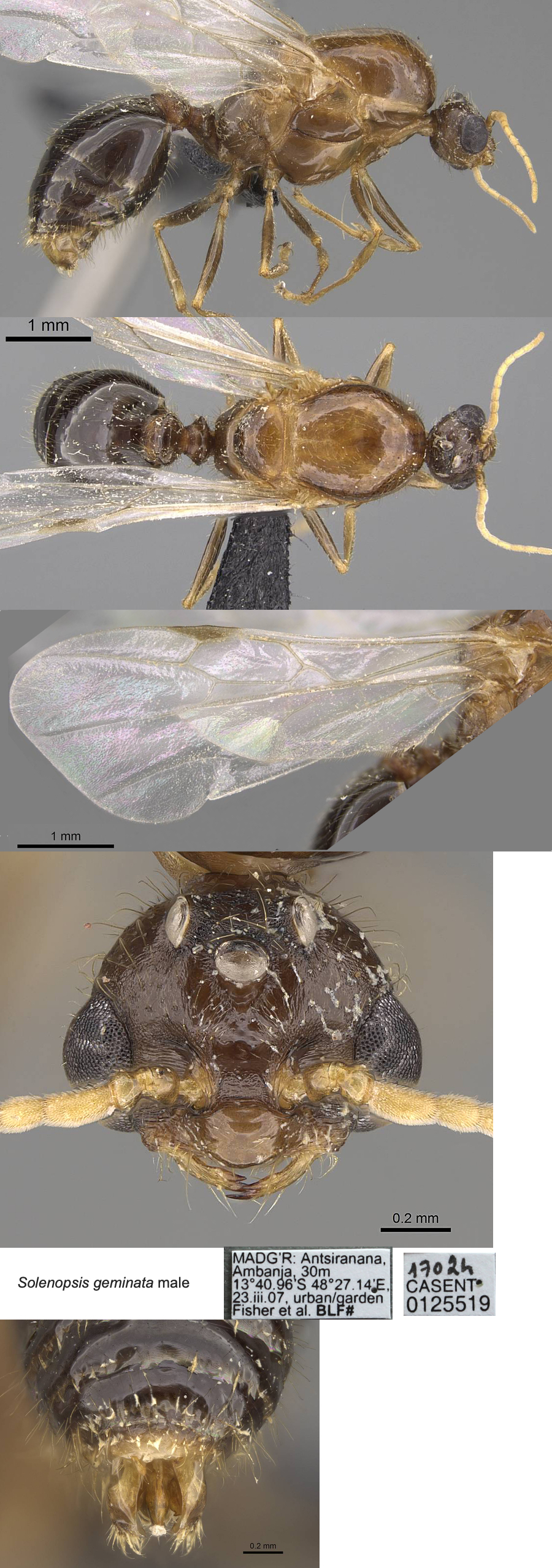 The
photomontage of
a fresh male is collated from http://www.antweb.org/specimen.do?name=casent0913894. The
photomontage of
a fresh male is collated from http://www.antweb.org/specimen.do?name=casent0913894.
|
|